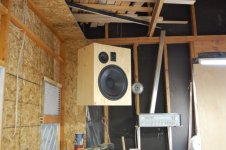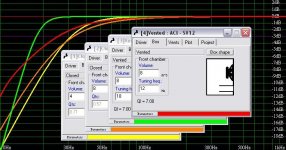Have there ever been any double-blind listening tests between ported and sealed subs with the same in-room response (at listening position, of course)? Just wondering how many people who prefer sealed subs to ported subs would consistently pick out sealed subs in such a test (low-to-medium SPL to prevent the advantage from going to the ported subs).
With suitable source material, it's fairly easy to tell the difference, unless your ported sub is quite a large alignment. Simply, the sealed sub will roll-off at around 12dB/octave, and the ported at around 24dB/octave (vast simplification here!).
Assuming un EQ'd bass (big assumption), the ported will have a flatter frequency response down to it's port tuning frequency and will then fade away quite quickly. The sealed will start rolling off sooner, but extend out more. If you take room 'boost' into account (which may be difficult do to reflection nodes), then you might find your ported sub to sound a lot boomier in the frequecy range between port frequency and where the room reflections start boosting the bass. The sealed, due to it's roll-off at around the same rate as the room boost, may not show this effect.
But, it really depends on the subwoofer and the room. There are many ported subs on the market, due it being quite cheap to get reasonable levels of bass out of a ported box (compared to a sealed one using the same amplification and size). I feel that you get better bass from a sealed than a ported - but that's a personal preference (and I'm talking below 50Hz, here). Others prefer open baffle (but I can't justify the size for a 20-50Hz subby) or bass horn (ditto) or tapped horn (haven't tried).
Assuming un EQ'd bass (big assumption), the ported will have a flatter frequency response down to it's port tuning frequency and will then fade away quite quickly. The sealed will start rolling off sooner, but extend out more. If you take room 'boost' into account (which may be difficult do to reflection nodes), then you might find your ported sub to sound a lot boomier in the frequecy range between port frequency and where the room reflections start boosting the bass. The sealed, due to it's roll-off at around the same rate as the room boost, may not show this effect.
But, it really depends on the subwoofer and the room. There are many ported subs on the market, due it being quite cheap to get reasonable levels of bass out of a ported box (compared to a sealed one using the same amplification and size). I feel that you get better bass from a sealed than a ported - but that's a personal preference (and I'm talking below 50Hz, here). Others prefer open baffle (but I can't justify the size for a 20-50Hz subby) or bass horn (ditto) or tapped horn (haven't tried).
Designing a ported sub such that its tuning frequency is above that of the lowest frequency required of it is rather disingenuous, wouldn't you say? This isn't supposed to be a test of good design vs bad design. Picking crap does nobody good.RobWells said:You mention that the ported would have an advantage over sealed at high volumes.. What about if your source material has plenty of output below the 'advantaged' ported subs tuning frequency ?
Rob.
Yes, which is why I qualified my post with "with the same in-room response".Cloth Ears said:
Assuming un EQ'd bass (big assumption), the ported will have a flatter frequency response down to it's port tuning frequency and will then fade away quite quickly. The sealed will start rolling off sooner, but extend out more. If you take room 'boost' into account (which may be difficult do to reflection nodes), then you might find your ported sub to sound a lot boomier in the frequecy range between port frequency and where the room reflections start boosting the bass. The sealed, due to it's roll-off at around the same rate as the room boost, may not show this effect.
454Casull said:
Just wondering how many people who prefer sealed subs to ported subs would consistently pick out sealed subs in such a test
Not many I'd guess.
Re: Re: Reflex vs sealed
Because there are not many good woofers made for AS any more. i.e. Fs<20 Hz with soft suspension. Apparently they are very hard to make with good QC.
MJL21193 said:
Not many I'd guess.
Because there are not many good woofers made for AS any more. i.e. Fs<20 Hz with soft suspension. Apparently they are very hard to make with good QC.
Re: Re: Re: Reflex vs sealed
http://www.aespeakers.com/drivers.php?driver_id=8
Hope on the horizoninfinia said:
Because there are not many good woofers made for AS any more. i.e. Fs<20 Hz with soft suspension. Apparently they are very hard to make with good QC.
http://www.aespeakers.com/drivers.php?driver_id=8
Re: Re: Re: Reflex vs sealed
I didn't have any problem finding some. By chance I found 4 relatively new 15" woofers at Goodwill that are perfect for acoustic suspension.
I used two for my workshop speakers:
infinia said:
Because there are not many good woofers made for AS any more. i.e. Fs<20 Hz with soft suspension. Apparently they are very hard to make with good QC.
I didn't have any problem finding some. By chance I found 4 relatively new 15" woofers at Goodwill that are perfect for acoustic suspension.
I used two for my workshop speakers:
Attachments
454Casull said:
Yes, which is why I qualified my post with "with the same in-room response".
Mr. Casull,
I agree with the above, but how do you propose do that?
Best Regards,
TerryO
Re: Re: Re: Re: Reflex vs sealed
IB and AS are different beasts.
AS uses a very soft suspension and needs a small sealed box.
IB has a stiff suspension and does not need an air load for support.
454Casull said:
IB and AS are different beasts.
AS uses a very soft suspension and needs a small sealed box.
IB has a stiff suspension and does not need an air load for support.
Ok so no testing with dvd's then -joke-
-joke-
Are you planning on keeping box sizes similar? I'd try a pair of drivers sealed versus a single ported. Usually the box size is dictated rather than amount of drivers.
Also what type of EQ will go below 20Hz ? My behringer stuff doesn't so I'm guessing it would be difficult to match the bottom roll off. Are you're planning to high pass the sealed box to match the ported ? (would that lose some advantage of going sealed ?)
Rob
Are you planning on keeping box sizes similar? I'd try a pair of drivers sealed versus a single ported. Usually the box size is dictated rather than amount of drivers.
Also what type of EQ will go below 20Hz ? My behringer stuff doesn't so I'm guessing it would be difficult to match the bottom roll off. Are you're planning to high pass the sealed box to match the ported ? (would that lose some advantage of going sealed ?)
Rob
===Just wondering how many people who prefer sealed subs to ported subs would consistently pick out sealed subs in such a test===
---Not many I'd guess.---
Many, I'd guess.
(sorry for contradiction)
In domestical conditions, I think BR are generaly prefered because of technical considerations and closed boxes because of subjective considerations. However a (fair ?) comparison would need more emitting area for the closed box.
The maximum bass efficiency for an IB claimed by AES as being 0.7 is mathematically wrong . It is 1.1.
---Not many I'd guess.---
Many, I'd guess.
(sorry for contradiction)
In domestical conditions, I think BR are generaly prefered because of technical considerations and closed boxes because of subjective considerations. However a (fair ?) comparison would need more emitting area for the closed box.
The maximum bass efficiency for an IB claimed by AES as being 0.7 is mathematically wrong . It is 1.1.
forr said:
Many, I'd guess.
(sorry for contradiction)
Hi,
I prefer BR - it will give you lower bass response for the driver selected.
However, the question posed by 454 was if the ported and sealed speakers have the same in room response, would you be able to distinguish them? I said I'd vote "no".
His point being that you would need to tell the difference based on the short-comings of the BR speaker (transient response, reinforcement of the low freq response using the back wave of the driver).
454Casull said:
Have there ever been any double-blind listening tests
between ported and sealed subs with the same in-room
response (at listening position, of course)?
Hi,
Simply put this is not possible without some ingenuity.
The sealed would need an active 2nd order highpass filter.
A sensibly vented box cannot be the same as sealed, below
the port frequency you cannot apply 12dB/octave bass boost.
That is sealed can be the same as vented, but not vice versa.
They would sound almost identical with whatever alignment you
choose as long as its sensible, althought one should note a quasi
6dB/octave alignment is possible for vented, needs EQ for sealed.
The main difference is volume capability around the port frequency
versus power handling and subsonics below the port frequency.
Correctly arranged blind listening tests at modest volumes would
show absolutely no difference between the two as the responses
are the same, as this implies everything is the same, i.e. phase,
group delay and transient response are also identical.
In reality they are two different animals. Vented alignments
are far more flexible and can fit in with room gain. Generally
for a driver the vented box could hold 2 of the same driver.
Attachments
Re: Re: Reflex vs sealed
It's the other way round. Sealed integrates better with in room gain than Vented. Although they both don't fit in perfectly.
Sealed generally is much easier on the ear with equal F-3dB (less boomy resultant). Room Gain is +6 dB/octave. see http://www.pvconsultants.com/audio/reflection/rrc.htm
Room Gain (+6dB/oct)
Sealed (-12dB/oct)
Vented EBS (-24dB/oct)
edit>
"for a driver the vented box could hold 2 of the same driver"
generally so can sealed
sreten said:In reality they are two different animals. Vented alignments
are far more flexible and can fit in with room gain. Generally
for a driver the vented box could hold 2 of the same driver.
/sreten.
It's the other way round. Sealed integrates better with in room gain than Vented. Although they both don't fit in perfectly.
Sealed generally is much easier on the ear with equal F-3dB (less boomy resultant). Room Gain is +6 dB/octave. see http://www.pvconsultants.com/audio/reflection/rrc.htm
Room Gain (+6dB/oct)
Sealed (-12dB/oct)
Vented EBS (-24dB/oct)
edit>
"for a driver the vented box could hold 2 of the same driver"
generally so can sealed
Hi,
What I meant is a one driver vented box can hold two sealed drivers.
For subs and their placement limitations you are correct regarding
room gain, I was thinking more of optimally placed loudspeakers
where depending on your room gain assumptions a low tuned
vented box can be adjusted somewhat to suit the room.
 /sreten.
/sreten.
What I meant is a one driver vented box can hold two sealed drivers.
For subs and their placement limitations you are correct regarding
room gain, I was thinking more of optimally placed loudspeakers
where depending on your room gain assumptions a low tuned
vented box can be adjusted somewhat to suit the room.
- Status
- This old topic is closed. If you want to reopen this topic, contact a moderator using the "Report Post" button.
- Home
- Loudspeakers
- Subwoofers
- Reflex vs sealed

